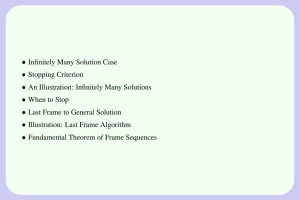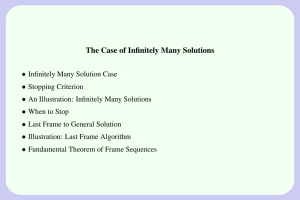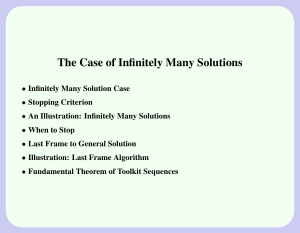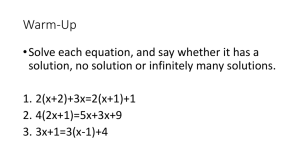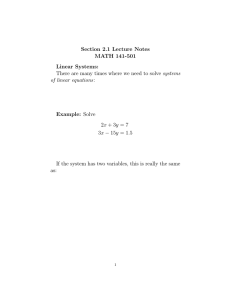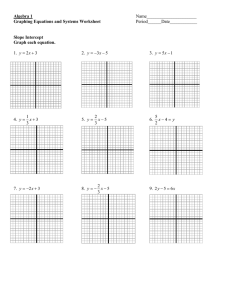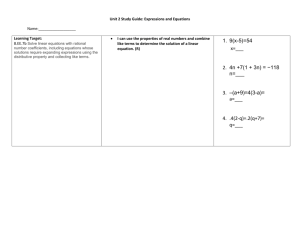The Case of Infinitely Many Solutions •
advertisement
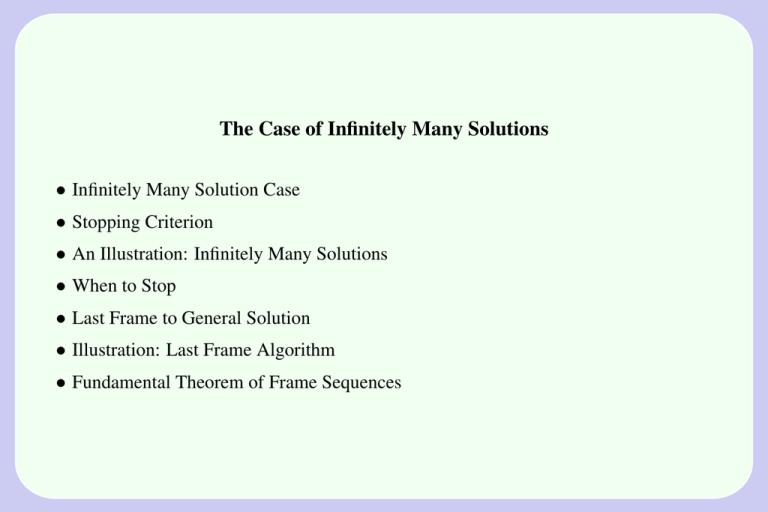
The Case of Infinitely Many Solutions • Infinitely Many Solution Case • Stopping Criterion • An Illustration: Infinitely Many Solutions • When to Stop • Last Frame to General Solution • Illustration: Last Frame Algorithm • Fundamental Theorem of Frame Sequences Infinitely Many Solution Case A system of equations having infinitely many solutions is solved from a frame sequence construction that parallels the unique solution case. The same quest for lead variables is made, hoping in the final frame to have just the variable list on the left and numbers on the right. Stopping Criterion A frame sequence terminates with the final frame, in either the case of a unique solution or infinitely many solutions, with exactly the same criterion: The last frame is attained when every nonzero equation has a lead variable. Remaining equations have the form 0 = 0. An Illustration: Infinitely Many Solutions We will solve by frame sequence methods, using the toolkit swap, combo, mult, the following system of equations: y + 3z = x + y = x + 2y + 3z = 1, 3, 4. x x x x + + + + x + − x + − x + x y y 2y 2y y y 2y y y 2y y + 3z = 1, = 3, + 3z = 4. + 3z = 4, = 3, + 3z = 1. + 3z = 4, − 3z = −1, + 3z = 1. + 3z = 4, − 3z = −1, 0 = 0. 2y + 3z = 4, y + 3z = 1, 0 = 0. − 3z = 2, y + 3z = 1, 0 = 0. Frame 1. Original system. Frame 2. swap(1,3) Frame 3. combo(1,2,-1) Frame 4. combo(2,3,1) Frame 5. mult(2,-1) Frame 6. combo(2,1,-2) Last Frame. Lead variables x, y . When to Stop The last frame is attained when every nonzero equation has a lead variable. Remaining equations have the form 0 = 0. x − 3z = y + 3z = 0 = 2, 1, 0. Last Frame to General Solution Once the last frame of the frame sequence is obtained, then the general solution can be written by a fixed and easy-to-learn last frame algorithm. This process is used only in case of infinitely many solutions. (1) Assign invented symbols t1 , t2 , . . . to the free variables.a (2) Isolate each lead variable. (3) Back-substitute the free variable invented symbols. a Computer algebra system maple uses these invented symbols, hence our convention here is to use t1 , t2 , t3 , . . . as the list of invented symbols. Last Frame Algorithm Illustration From the last frame of the frame sequence, x − 3z = y + 3z = 0 = 2, 1, 0, Last Frame. Lead variables x, y . the general solution is written as follows. z = t1 x = 2 + 3z, y = 1 − 3z x = 2 + 3t1, y = 1 − 3t1, z = t1. The free variable z is assigned symbol t1 . The lead variables are x, y . Isolate them left. Back-substitute. Solution found. The solution found in the last step is called a standard general solution. The meaning is that all solutions of the system of equations can be found by specializing the invented symbols t1 , t2 , . . . to particular numbers. Also implied is that the general solution expression satisfies the system of equations for all possible values of the symbols t1 , t2 , . . . . A Fundamental Theorem Theorem 1 (Fundamental Theorem of Frame Sequences) • A general solution obtained from the last frame algorithm has the fewest possible parameters. • The Last Frame is unique. Given an ordering of the variables, every last frame obtained by using the Three Rules is identical. • Any general solution having the fewest possible parameters represents each solution of the linear system by exactly one set of parameter values. This is a uniqueness theorem. If a solution is written using one set of parameter values, and a second solution is written with different parameter values, then the two solutions have to be different. Briefly, the general solution representation is not redundant. Reading the proof is recommended for the mathematically inclined, after understanding the examples. See web links for the text of the proof.
